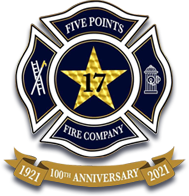Frequently Asked Questions
Why does a firetruck come when you call for an ambulance?
When calls for an emergency are recieved, its difficult to tell how severe the emergency will be until the responders arrive to the patient, so in some cases, a firetruck will be sent with more manpower to assist the ambulance crew. Our engines, rescue, and ladder truck all carry emergency medical care equipment and a majority of our volunteers are certified EMT's with a handful of our members being certified paramedics. Depending upon the severity of the response, a firetruck could be sent back to the station to respond to other emergencies, or remain on scene to assist with patient care.
Why do you block traffic lanes at automobile accidents?
Traffic lanes are blocked on automobile accidents for the safety of our emergency personnel and patients. During these incidents, an apparatus acts as a protective barrier between the vehicles on the highway and the personnel operating on the scene.
What should I do if I see a stopped emergency vehicle with its lights activated?
In 2006, the State of Delaware adopted a law to protect emergency workers and first responders working alongside the highways. The "Move Over" law requires any driver approaching a stopped emergency vehicle that has its lights activated, to either move over into a lane that is not next to the emergency vehicle, or to reduce his or her speed to a "safe speed" while passing the emergency vehicle if changing lanes would be impossible or unsafe. Click here for more information on the Move Over Law.
Is it safe for me to drive over fire hose?
No. Driving over fire hose could place too much pressure on the hose and cause a rupture, cutting off a much needed water supply to the apparatus and the members its going to. Losing water could place fire personnel at serious risk. Please avoid driving near fire hose and drive carefully around fire scenes.
Why do I need to keep weeds and bushes away from fire hydrants on my property?
Fire Hydrants must be kept clear of all shrubbery at least 3 feet in all directions, and cleared to the road. Time is prescious during an emergency. If a hydrant is not properly cleared of all shrubbery or snow, firefighters will have difficulty making the proper connections, which will delay suppression activities.
Can you get my cat out of a tree?
We certainly will attempt to assist with rescuing animals. Cats are known to eventually come down from trees, but if you have continuing concerns you can contact Delaware Animal Control
What do I do if I smell gas in my home?
Exit your home immediately and dial 911.
What is the best kind of fire extinguisher for my home?
The National Fire Protection Association recommends selecting a multi-purpose extinguisher that is large enough to put out a small fire, but not so heavy it is too difficult to handle. Visit NFPA.org for more information on how to safely use portable fire extinghuishers.
What should I do if I see or hear an emergency vehicle?
According to Chapter 10, Section 2 of Delaware traffic laws, when you are approached by an emergency vehicle, do not stop in the middle of an intersection, but instead pull over to the right side of the road as soon as possible.


